Lipopolysaccharide fever is initiated via a capsaicin-sensitive mechanism independent of the subtype-1 vanilloid receptor
- PMID: 15492017
- PMCID: PMC1575955
- DOI: 10.1038/sj.bjp.0705977
Lipopolysaccharide fever is initiated via a capsaicin-sensitive mechanism independent of the subtype-1 vanilloid receptor
Abstract
As pretreatment with intraperitoneal capsaicin (8-methyl-N-vanillyl-6-nonenamide, CAP), an agonist of the vanilloid receptor known as VR1 or transient receptor potential channel-vanilloid receptor subtype 1 (TRPV-1), has been shown to block the first phase of lipopolysaccharide (LPS) fever in rats, this phase is thought to depend on the TRPV-1-bearing sensory nerve fibers originating in the abdominal cavity. However, our recent studies suggest that CAP blocks the first phase via a non-neural mechanism. In the present work, we studied whether this mechanism involves the TRPV-1. Adult Long-Evans rats implanted with chronic jugular catheters were used. Pretreatment with CAP (5 mg kg(-1), i.p.) 10 days before administration of LPS (10 microg kg(-1), i.v.) resulted in the loss of the entire first phase and a part of the second phase of LPS fever. Pretreatment with the ultrapotent TRPV-1 agonist resiniferatoxin (RTX; 2, 20, or 200 microg kg(-1), i.p.) 10 days before administration of LPS had no effect on the first and second phases of LPS fever, but it exaggerated the third phase at the highest dose. The latter effect was presumably due to the known ability of high doses of TRPV-1 agonists to cause a loss of warm sensitivity, thus leading to uncontrolled, hyperpyretic responses. Pretreatment with the selective competitive TRPV-1 antagonist capsazepine (N-[2-(4-chlorophenyl)ethyl]-1,3,4,5-tetrahydro-7,8-dihydroxy-2H-2-benzazepine-2-carbothioamidem, CPZ; 40 mg kg(-1), i.p.) 90 min before administration of LPS (10 microg kg(-1), i.v.) or CAP (1 mg kg(-1), i.p.) did not affect LPS fever, but blocked the immediate hypothermic response to acute administration of CAP. It is concluded that LPS fever is initiated via a non-neural mechanism, which is CAP-sensitive but RTX- and CPZ-insensitive. The action of CAP on this mechanism is likely TRPV-1-independent. It is speculated that this mechanism may be the production of prostaglandin E(2) by macrophages in LPS-processing organs.
Figures
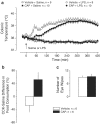
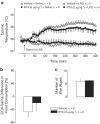
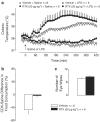
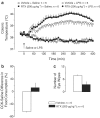
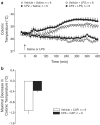
Similar articles
-
Involvement of a capsaicin-sensitive TRPV1-independent mechanism in lipopolysaccharide-induced fever in chickens.Comp Biochem Physiol A Mol Integr Physiol. 2007 Nov;148(3):578-83. doi: 10.1016/j.cbpa.2007.07.012. Epub 2007 Aug 8. Comp Biochem Physiol A Mol Integr Physiol. 2007. PMID: 17761445
-
Activation of vanilloid receptor 1 by resiniferatoxin mobilizes calcium from inositol 1,4,5-trisphosphate-sensitive stores.Br J Pharmacol. 2003 Jan;138(1):172-6. doi: 10.1038/sj.bjp.0705003. Br J Pharmacol. 2003. PMID: 12522087 Free PMC article.
-
Capsaicin pretreatment attenuates LPS-induced hypothermia through TRPV1-independent mechanisms in chicken.Life Sci. 2008 Jun 6;82(23-24):1191-5. doi: 10.1016/j.lfs.2008.04.003. Epub 2008 Apr 15. Life Sci. 2008. PMID: 18474376
-
The vanilloid receptor and hypertension.Acta Pharmacol Sin. 2005 Mar;26(3):286-94. doi: 10.1111/j.1745-7254.2005.00057.x. Acta Pharmacol Sin. 2005. PMID: 15715923 Review.
-
Resiniferatoxin and its analogs provide novel insights into the pharmacology of the vanilloid (capsaicin) receptor.Life Sci. 1990;47(16):1399-408. doi: 10.1016/0024-3205(90)90518-v. Life Sci. 1990. PMID: 2174484 Review.
Cited by
-
Effects of opioids, cannabinoids, and vanilloids on body temperature.Front Biosci (Schol Ed). 2011 Jun 1;3(3):822-45. doi: 10.2741/190. Front Biosci (Schol Ed). 2011. PMID: 21622235 Free PMC article. Review.
-
The hypothermic response to bacterial lipopolysaccharide critically depends on brain CB1, but not CB2 or TRPV1, receptors.J Physiol. 2011 May 1;589(Pt 9):2415-31. doi: 10.1113/jphysiol.2010.202465. Epub 2011 Mar 14. J Physiol. 2011. PMID: 21486787 Free PMC article.
-
TRPV1 antagonists that cause hypothermia, instead of hyperthermia, in rodents: Compounds' pharmacological profiles, in vivo targets, thermoeffectors recruited and implications for drug development.Acta Physiol (Oxf). 2018 Jul;223(3):e13038. doi: 10.1111/apha.13038. Epub 2018 Feb 16. Acta Physiol (Oxf). 2018. PMID: 29352512 Free PMC article.
-
Capsaicin-induced Ca2+ signaling is enhanced via upregulated TRPV1 channels in pulmonary artery smooth muscle cells from patients with idiopathic PAH.Am J Physiol Lung Cell Mol Physiol. 2017 Mar 1;312(3):L309-L325. doi: 10.1152/ajplung.00357.2016. Epub 2016 Dec 15. Am J Physiol Lung Cell Mol Physiol. 2017. PMID: 27979859 Free PMC article.
-
Morphological study of the postnatal hippocampal development in the TRPV1 knockout mice.Temperature (Austin). 2023 Feb 3;10(1):102-120. doi: 10.1080/23328940.2023.2167444. eCollection 2023. Temperature (Austin). 2023. PMID: 37187833 Free PMC article.
References
-
- AVELINO A., CRUZ F. Peptide immunoreactivity and ultrastructure of rat urinary bladder nerve fibers after topical desensitization by capsaicin or resiniferatoxin. Auton. Neurosci. 2000;86:37–46. - PubMed
-
- BÍRÓ T., MAURER M., MODARRES S., LEWIN N.E., BRODIE C., ÁCS G., ÁCS P., PAUS R., BLUMBERG P.M. Characterization of functional vanilloid receptors expressed by mast cells. Blood. 1998;91:1332–1340. - PubMed
-
- CATERINA M.J., LEFFLER A., MALMBERG A.B., MARTIN W.J., TRAFTON J., PETERSEN-ZEITZ K.R., KOLTZENBURG M., BASBAUM A.I., JULIUS D. Impaired nociception and pain sensation in mice lacking the capsaicin receptor. Science. 2000;288:306–313. - PubMed
-
- CATERINA M.J., ROSEN T.A., TOMINAGA M., BRAKE A.J., JULIUS D. A capsaicin-receptor homologue with a high threshold for noxious heat. Nature. 1999;398:436–441. - PubMed
Publication types
MeSH terms
Substances
Grants and funding
LinkOut - more resources
Full Text Sources
Medical
Research Materials
Miscellaneous

